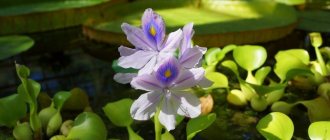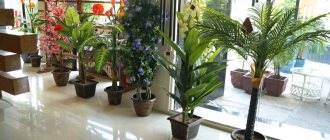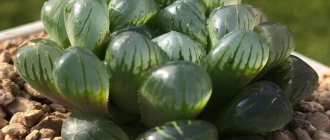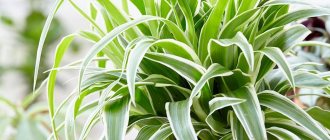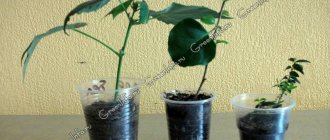How can you get poisoned from house plants?
Poisoning can occur after:
-eating leaves or touching leaves;
- ingestion of berries, flowers or plant roots;
- skin contact with plant sap;
-eating soil, soil from under plants;
-drinking water from pallets.
Most flower shops do not carry warning labels on potted plants that indicate possible toxicity or toxicity.
Therefore, before purchasing this or that beautiful flower, find out everything about this plant, in particular, what potential threat it poses to your family members and pets.
Spurge
All plants of the euphorbia family, including domestic ones, are dangerous due to their poisonous sap. Some representatives of the species look like cacti, others are very attractive floral ones. But regardless of the “appearance”, the juice is a huge danger. Once in the body, it causes:
- nausea;
- diarrhea;
- dizziness;
- burns of the mucous membrane.
Beautiful and dangerous spurge
Harmful house plants
1. Philodendron
Philodendrons are many people's favorite houseplants.
Perhaps this is one of the most popular house plants. The advantages of the flower are obvious: it has an attractive appearance, grows quickly and is not particularly whimsical.
But while this plant is a perfect addition to any room, it contains calcium oxalate crystals, which are toxic to humans and animals.
Philodendrons can be climbing or non-vining. It is very important to keep climbing plants hanging out of the reach of children or pets, and to trim leaves and tendrils regularly.
Non-climbing plants should be stored on high window sills or shelves so that children or animals cannot reach them.
Side effects in humans:
People, especially young children, may experience the following reaction to the plant: dermatitis, skin irritation, swelling of the mucous membranes and upset of the digestive system when eating the leaves of the plant.
There are several known cases where, after children ate leaves, the incident ended in death.
Effect of the plant on cats and dogs:
Philodendron has a much more serious impact on pets. We can talk about spasms, cramps, pain and swelling.
By the way, the plant poses the greatest threat to cats.
2. Epipremnum aureus
Epipremnum aureus, or commonly known as devil's ivy, is considered one of the most popular indoor plants. It does an excellent job of purifying indoor air.
In addition, the attractive appearance of the plant will leave few people indifferent. Beautiful variegated leaves are a real decoration for the room.
Devil's ivy is, in fact, considered one of the most beneficial indoor plants for removing harmful impurities from the air.
The advantage of the flower is also that it propagates easily and quickly from its own cuttings. So pretty soon you have an entire mini plantation of devil's ivy in your home.
However, is it safe for household members?
It is believed that in small quantities this plant causes almost no harm. But in rare cases, it can also cause serious side effects in animals and people.
Side effects in humans:
Burning in the mouth, skin irritation, swelling of the lips, tongue and throat, vomiting, cramping and diarrhea.
Effect of the plant on cats and dogs:
Drooling, choking, swelling of the mouth and tongue, difficulty breathing, and upset stomach. In some cases, the plant can also lead to kidney failure and/or death.
3. Syngonium peduncle
Many people confuse this plant with Philodendron. Indeed, they are similar and it is also very easy to care for.
It is usually mixed in gardens with other plants that require similar care. This undeniably beautiful plant has heart-shaped leaves and is often given as a gift to loved ones.
Young plants are very bushy. Older plants produce arrow-shaped stems and leaves.
The flower regularly sheds its leaves and produces new shoots, therefore, it is recommended to regularly check the plant and clean it of fallen leaves.
Side effects in humans and animals:
Irritated skin, upset stomach, vomiting.
Hydrangea
This is one of the plants that has poison in all parts. Of course, just touching hydrangea is not dangerous, but the juice provokes increased sweating, impairs blood circulation, causes itching, nausea, muscle weakness, and stomach pain.
If you have small children in the house, you should reconsider your color preferences.
Dangerous house plants
4. Lilies (and all the plants we call lilies)
Most types of lilies, including the so-called Asiatic lily, are very toxic. They pose a particular danger to cats.
Everyone knows this beautiful flower. Few flowers can boast such beauty, grace and elegance as the lily.
These delicate plants are often used to decorate rooms, and many flower fans happily keep them in their bedrooms and children’s rooms. This is absolutely forbidden to do!
Of course, not all lilies are toxic, and some can only harm animals. However, if you are not sure what type of lily is growing in your pot, it is best to err on the side of caution.
Be careful with lilies!
You shouldn't keep them indoors. But if you love this flower so much and are not ready to give it up completely, then the best solution would be to plant lilies in the garden or front garden. In other words, this flower will become absolutely safe outdoors.
More toxic varieties of lilies include the following plants:
-Calla lily (which can be fatal to children);
-Easter lily;
-Lily rubrum;
-Tiger lily;
-Daylily or day lily;
-Asiatic lily.
Depending on the type, lilies can cause poisoning, which will manifest itself in various symptoms. As mentioned above, it is cats that are more susceptible to the poison of this flower.
Side effects in humans:
Stomach upset, vomiting, headache, blurred vision and skin irritation.
Effect of the plant on cats:
All parts of the lily are considered toxic. Symptoms of poisoning include vomiting, drowsiness and lack of appetite. Kidney and liver failure, if not treated promptly, can lead to the death of the animal.
5. Spathiphyllum
Although spathiphyllum are not true lilies, they are often classified as this particular species. They are as toxic as lilies and pose some danger to people and pets.
Remember, the peace lily, or Spaphyphyllum, is not a member of the lily plant family.
There are many varieties of the peace lily, such as Mauna Loa, a popular flower among gardeners. This type of plant is one of the most common plants for home decor and room decoration.
With glossy leaves and a unique white flower that blooms majestically among the leaves, this evergreen perennial from South America looks quite impressive.
In addition, these plants love shade, which makes them ideal for apartments and rooms with little sunlight.
They are also excellent air purifiers. However, like the previous plants on this list, they can cause painful symptoms and sometimes cause death when ingested by people or animals.
Side effects in humans:
Lips, mouth and tongue burn and swell, swallowing reflexes are difficult, vomiting, nausea and diarrhea are lost, speech is lost.
Effect of the plant on animals:
Information about the toxicity of peace lilies is quite controversial. However, some sources provide information about harm to dogs and cats.
In case of plant poisoning, the following symptoms are observed: burning of the skin, excessive salivation, diarrhea, dehydration, lack of appetite and vomiting. If treatment is not started in time, poisoning can lead to kidney failure, which ultimately leads to the death of the animal.
Dieffenbachia
This rather massive plant with large leaves goes well with the interior of any home or office. It is not surprising that the popularity of Dieffenbachia is enormous. In addition, the chemical composition of the air improves, but there is no need to rush to place it in the children's room. The most poisonous element is the juice contained in the stem. It can cause serious digestive disorders. May cause burns if in contact with skin.
Advice! When caring for Dieffenbachia, it is better to use gloves - this will prevent damage to the skin of your hands.
Diefenbachia in the interior
Oleander
Its flowers are magnificent and smell great of spices. But too much of this aroma leads to headaches and dizziness. Due to intensive growth, the number of inflorescences increases exponentially. The main danger lies in the leaves: if even a small leaf gets into food, it can be fatal.
Very fragrant dangerous oleander
Monstera
It is also called holey philodendron. Again, excellent appearance and decorative qualities. Openwork leaves, despite their excellent appearance, are poisonous to humans and animals. If they get into the mouth, a strong burning sensation occurs, salivation increases, and inflammation develops. If swallowed, it may cause indigestion and inflammation of the intestines.
Monstera's large, luxurious leaves are also very dangerous.
Description of the flower
Some species are grown as a house flower, which attracts with the beauty of its foliage. Alocasia belongs to the aroid family, and there are about 50 species in its genus. All species are united by the dense structure of the leaves; the stems on which they are located are also fleshy and elongated.
Whatever the shape of the leaf, its tip is pointed, the veins stand out well. And the surface of the leaf has the ability to release water, they say that it cries. In nature, this happens during the rainy season, but alocasia at home sheds tears when there is too much watering.
Only a few species of this plant are grown at home; sizes can reach up to one meter. If the same variety grows in open soil, then its height is up to 3 meters. Compared to the foliage, the alocasia flower is not particularly beautiful.
They appear quite rarely and even then it is recommended to remove them so that the plant’s strength is not wasted on flowers and fruits. Flower development can help reduce the growth of the leaves themselves, which are the main decorative component of the plant.
The flowers themselves are small, white or pinkish, collected in a group in the form of a cob, protected on one side by a leaf, like a blanket. The flowers emit a pleasant aroma. Afterwards, fruits appear in the form of berries, inside of which there are seeds. If the leaves of the plant are important as a decorative component, the flower is cut off, it is better to sprinkle the cut itself with something so that it dries; in practice, it is good to use crushed coal.

